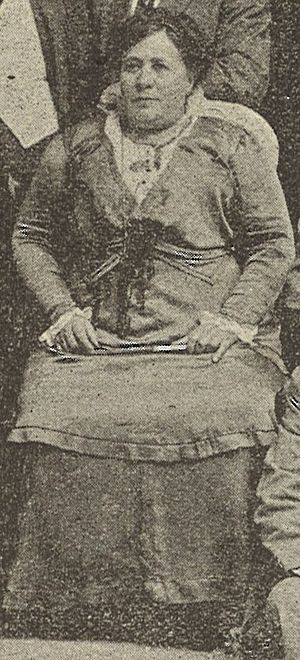Eva Canel facts for kids
Eva Canel (born Agar Eva Infanzón Canel on January 30, 1857, in Coaña, Asturias, Spain – died May 2, 1932, in Havana, Cuba) was a talented writer and journalist. She was originally from Spain but later lived and worked in Cuba. She became very well known by her pen name, Eva Canel.
Contents
The Early Life of Eva Canel
Eva Agar was born on January 30, 1857, in Coaña, a town in Asturias, Spain. Her parents were Doctor Pedro Infanzón and Epifanía Canel y Uría. When Eva was only three years old, her father sadly died in a shipwreck caused by pirates. After this, Eva and her mother moved to Madrid.
When Eva was fifteen, she started working as an actress in the theater. There, she met Eloy Perillan y Buxo, who was the director of a funny magazine called La Broma. Eva and Eloy got married that same year.
Adventures in Journalism
In 1874, Eloy had to leave Spain. This happened because he published something that the government didn't like, and they made him leave the country. He went to Bolivia, and Eva took over as the director of La Broma magazine.
A year later, Eva traveled to South America to join her husband. They worked together on El Ferrocarril, a magazine Eloy directed in La Paz, Bolivia. In January 1875, the couple moved to Buenos Aires, Argentina. There, they started a new magazine called El Petróleo. This is when Eva began working full-time as a journalist.
In 1876, Eva and Eloy moved again, this time to Lima, Peru. They started another newspaper called Las Noticias. They also wrote for other newspapers like El Comercio and El Perú Ilustrado. While they were in Peru, their only child was born, and they named him Eloy, just like his father.
Returning to Spain and Cuba
Because of the War of the Pacific between Peru and Chile, Eva and her family returned to Spain. They settled in Barcelona. However, Eloy later moved to Cuba, where he passed away on March 1, 1889.
Eva moved to Cuba a short time later. She tried to find work at two Cuban newspapers, Diario de la Marina and Unión Constitucional. But the people in charge of those newspapers would not hire her.
So, in 1891, Eva decided to start her own weekly newspaper called La Cotorra. This newspaper was known for its clever jokes and comments about politics.
After eight years in Cuba, and after the Cuban War of Independence ended, Eva returned to Spain. She moved back to Madrid. However, in 1899, she went back to Buenos Aires, Argentina. This was a very productive time for her writing. She wrote three novels, gave many talks, and wrote for various newspapers. She even owned her own printing press and started two more magazines: Kosmos in 1904 and Vida Española in 1907.
Later Life and Legacy
On July 15, 1905, Eva gave an important speech at a special event at the Teatro Español in Madrid. This event was part of the celebrations for the opening of a new hospital. She spoke about "Charity" and received a big round of applause.
In 1914, Eva began a trip through Latin America. But she became ill when she arrived in Panama. She first thought about going to a clinic in the United States. Instead, she returned to Cuba, where her friend Antonio Díaz Blanco helped her.
Eva continued her writing and journalism in Cuba until 1924. Around this time, her health got worse, and she started to have trouble remembering things. Eva Canel passed away on May 2, 1932, in Havana, Cuba. She was buried in her hometown in Spain.
What Eva Canel Wrote
Eva Canel's writing showed many different influences and styles. She used various techniques, from Romanticism (focusing on feelings and imagination) to Naturalism (showing life as it really is, even the difficult parts). Sometimes, she would even say that her husband, Eloy Perillán Buxó, wrote her works instead of herself.
Novels
- Manolín (1891)
- Trapitos al sol (1891)
- Oremus (1893)
- El agua turbia (1906)
Theater Plays
- La mulata (1891)
- El indiano (1894)
- Fuera de la ley (1902)
- Agua de limón (1904)
- La abuelita (1905)
- De Herodes a Pilatos (1905)
- Uno de Baler (1907)
Other Writings
- Cosas del otro mundo. Viajes, historias y cuentos americanos (1889) (Things from the Other World. Travels, Stories, and American Tales)
- Magosto. Colección de tradiciones, novelas y conferencias asturianas (1894) (Magosto. Collection of Asturian Traditions, Novels, and Lectures)
- Álbum de la Trocha. Breve reseña de una excursión feliz desde Cienfuegos a San Fernando, recorriendo la línea militar (1897) (Album of the Trocha. Brief Review of a Happy Excursion from Cienfuegos to San Fernando, Traveling the Military Line)
- De América. Viajes, tradiciones y novelitas cortas (1899) (From America. Travels, Traditions, and Short Novels)
- Lo que vi en Cuba. A través de la isla (1916) (What I Saw in Cuba. Across the Island)
See also
 In Spanish: Eva Canel para niños
In Spanish: Eva Canel para niños


